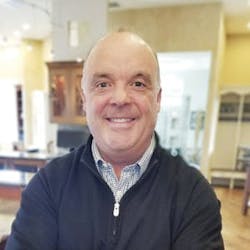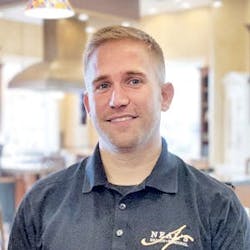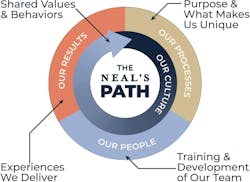Alan Hendy will pay you to leave his company—$500 in cold hard cash. Tempting, though nobody bites.
It’s a test that, by now, team members know is coming at the 90-day new employee check-in. But it’s not testing the newcomer as much as it’s testing Neal’s Design Remodel.
“Our 90-day review, for me, is one of the most wonderful meetings I get to do,” says Alan, CEO of the Cincinnati-based design-build remodeling company. “I’m going to ask them, ‘How did we do on your onboarding?’ Did you see [our values] come to life or are we full of it?’”
Neal’s opened in 1972 and is in its second-generation leadership—with the third-gen warming up, Co-Owner and Project Consultant Mike Hendy. Alan is determined for Neal’s to hit the 100-year mark and aims to get there through its people development, and processes—a relatively newer focus for the 52-year-old company.
Neal’s History
Founder Neal Hendy opened Neal’s on his 40th birthday with six children at home and nothing in his bank account.
“He was completely bankrupt. I don’t think he’s very proud of that, but he didn’t have anything,” says Alan, one of those six children.
The founder did have experience as a home builder alongside two brothers. The three took over their father’s building company after he passed away in the Korean War and built the company up and up, without knowing much about its profitability. To them, growth was growth. Neal’s was born from the ashes of that first company.
“Their focus was always on making sure that, more than just your standard contractor, we would have a high level of customer service,” says Alan.
By 1980, Neal’s had $1.2 million in annual sales with nine team members, and the company continued to see strong, steady growth over the decades.
Intentional Leadership
Neal’s found itself in an eerily familiar situation a few years after Neal Hendy’s retirement in 2006. Three brothers from the next generation took over the firm. Revenues stayed strong but Neal’s found itself pushing 50 employees, and the three felt a weight of responsibility and a lack of one leader. It was decided that Alan would take on that role.
“I made it my point when they asked me to do that, that I was going to be very intentional about how we attract and keep the best talent possible,” says Alan. “I had studied Ritz-Carlton. I had studied all the greats. And I wanted to have a culture that people come visit it’s so cool.”
He also studied at Aileron, a business advisory firm focused on leadership, people development, and culture. His $500 test at the 90-day mark? An old Zappos trick.
Today, there’s another owner at Neal’s who aligns himself with people development as a top passion. Derek Gannaway, sales/operations manager and co-owner, became a partner in 2023. To Hendy, Gannaway is cut from the same cloth and embodies servant leadership principles—a major Neal’s cultural focus. To Gannaway, the ownership also represents the possibilities that team members have at Neal’s and locks in a succession with a people-first mindset at the forefront.
“All of these pieces and parts that we’ve picked up over time have helped this company become great,” says Gannaway. “Alan’s vision [is] that we have to have a great culture in order to grow as a company.”
Putting it Into Play
Production Manager James Rebholz had owned a remodeling company and began pouring concrete with his brother to fill gaps between jobs. Rebholz’s brother worked for Neal’s as a subcontractor, and before Rebholz’s first job, he had to warn him.
“He’s like, ‘They’re kind of weird,’” recalls Rebholz. “I was like, ‘What do you mean?’ He said, ‘They’re all really nice.’”
Neal’s always hired nice people who offered exceptional customer service, solidified by Neal’s Customer Pledge, started in 1994 by Neal Hendy. Alan recognized the next step for intentional culture, which creates a strong company, was affirming the people part of the company’s purpose.
He developed a board of directors, filled it with a variety of professionals, including an industry psychologist, and created a family charter. Then together as a company, Neal’s Social Covenant was developed and a Neal’s Cares team. Then came Neal’s Path. And Neal’s five core values, and a focus on a legacy of servant leadership.
Culture Timeline
Employees make up the Neal’s Care team, which plans and executes internal events like Meet Fest, the annual gathering for all employees (with, of course, grilled meats), and the Neal’s Family Picnic. The group also oversees external events such as volunteer opportunities, and they play a vital role in the interview process.
It’s these team members who embody the company’s five core values that help gauge the compatibility of potential hires. The importance of the right people in the right seats is key to Neal’s success, and the interview process can take months. (In Gannaway’s case, it was six months).
Alan is the first to talk with new hires on day one when they receive their culture core training. He starts with the Neal’s history, then gets into the Neal’s Path. It’s how Alan and his team show that proven results tie into processes, which connect to the team, and are supported by shared values and the culture.
The Neal’s purpose is “Building better lives at home,” and that comes first for the most important clients, the internal ones, says Alan.
“I know that many people have very difficult lives, very different lives. And if their life is a mess, let’s say, then their work should be an oasis from that,” says Alan. “Their work should be a place where they can have stability and growth and respect and quiet.”
It’s also the purpose of the Social Covenant. Each employee signs a promise to not gossip and to apologize, and to hold one another accountable for those promises.
“This is a stressful business. If we don’t have each other’s back, it’s not going to work,” says Designer Cyndi Kohler. “We truly are in my mind, like a family.”
The newest addition to Neal’s culture is independent development plans (IDP), introduced by co-owner Gannaway, and inspired by his time in the military. It’s a five-page questionnaire prompting employees to share things like top values, personal and professional goals, and interest in specific positions. Progress is discussed during the employee’s semiannual review, with opportunity to revise.
“I’m a carpenter, I’ve always worked with my hands,” says Production Manager Rebholz. “I identify as a smart carpenter, but I didn’t even know what an IDP was. I wrote an IDP and let them in on the fact that I would love to be a production manager here someday, or assistant production manager.”
Rebholz thinks Gannaway knew his ultimate goal before the IDP, but it provided Rebholz a way to express his career path goals. It also helped Neal’s find the person who they’d train up to fill a production manager vacancy. Rebholz began his new role Jan. 1, 2023.
Systems That Work
Alan systematized a value-first culture to attract, keep, and develop the best talent—his ultimate goal. Gannaway would come in to help systematize the operations.
Gannaway was hired initially without a title. Alan knew he’d fit right in, so found him somewhere to start, which was in design support. Gannaway gained experience in every aspect of the company and then went all in on operations. He developed KPI dashboards, workload management, and rethought dozens of Excel sheets of data.
The team tried and tested various iterations of the design, production, and sales processes, and today, all departments feel strongly positive about their workflows.
The 31-member production department has a manager and two field managers who each oversee 11 lead carpenters. The team tried structures with two production managers with leads and carpenters, and one production manager with field managers and up to nine lead carpenters. Ultimately, project managers didn’t work for the team, and challenges with hiring and managing growth came into play.
Rebholz says their system today greatly improved quality and experience. Plus, it’s a scalable model, making it perfect to reach Neal’s next goal of $20 million in sales revenue. But its ultimate success comes down to people.
Designer Cyndi Kohler says that it’s Neal’s sales and design structure that separates it from other local remodelers. The company operates with separate designer and sales teams, and Kohler says it’s a big factor that helps the company work in up to 100 homes annually.
“With our volume, there’s no way the designers could sell the amount of projects that we have on our plate,” she explains.
Boomerangs
The greatest sign of Neal’s culture and systems working well is what the company calls its boomerangs—employees that left but returned.
These team members found other opportunities, whether financially better, a promotion, or change in industry, but decided to return to Neal’s.
Most of these individuals are on the production team, with seven out of the 31 employees considered boomerangs. One left for two weeks then returned. Another returned after 17 years.
“When people come back to Neal’s, it is the most powerful story,” says Alan. “We want them to feel like they’re not taking a chance leaving here. They’re outstanding. If they can go get more money, go get it. But if you miss the culture, if you miss this place, if you miss the problem-solving, it’s not risky to leave here because you’ll be welcomed back.






